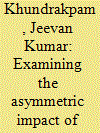| Srl | Item |
| 1 |
ID:
155101


|
|
|
|
|
| Summary/Abstract |
Though an accumulating body of work has analysed monetary policy transmission in India, there are few studies examining the asymmetric aspect of the transmission. Against this backdrop, segregating the interest rate setting process captured by a Taylor rule type into unanticipated and anticipated components, this article analyses the asymmetric effects of monetary policy on aggregate demand and its components, and inflation in India using quarterly data from 1996–97Q1 to 2013–14Q3. It finds that unanticipated hikes and cuts in the policy rate have a symmetric impact on aggregate demand, but differentially impact the components. While the impacts on investment are negative and symmetric, they are asymmetric on private consumption, with only an unanticipated cut in policy rate having a significant negative impact. Government consumption is unaffected by monetary policy shocks. The impact of unanticipated interest rate changes on inflation is negative and symmetric. Anticipated policy rate changes also have a negative impact on aggregate demand and its components, except for government consumption, but between certain levels, such changes are ineffective, indicating a neutral impact. Anticipated policy rate changes have a negative impact on inflation at all levels.
|
|
|
|
|
|
|
|
|
|
|
|
|
|
|
|
| 2 |
ID:
157668


|
|
|
|
|
| Summary/Abstract |
The present study assesses the empirical performance of the new Keynesian IS model by estimating the standard as well as extended specifications of both the backward-looking and hybrid models in India over the period 1998Q1 to 2015Q4. It is found that the backward-looking IS model fits the data quite well in comparison with the hybrid model. The link between the policy rate and output gap appeared to be a bit stronger in the extended backward-looking IS model, as the interest rate coefficient is larger. Also, besides the interest rate, the real exchange rate, external demand and crude oil prices also have an impact on aggregate demand. The results suggest that the standard specification of the IS curve is inadequate to estimate the impact of the interest rate on aggregate demand and therefore a broader framework which accounts for additional variables besides the interest rate may be required.
|
|
|
|
|
|
|
|
|
|
|
|
|
|
|
|
| 3 |
ID:
160031


|
|
|
|
|
| Summary/Abstract |
We estimate the determinants of credit and of non-performing assets (NPAs) using a firm and a bank panel with data up to 2015 in order to test bank lending against the aggregate demand channel as an explanation for slow Indian credit growth. The results support demand as the key constraint. Only demand variables affect corporate credit for a broad set of firms. Balance sheet weakness reduced credit only for a narrow subset of indebted firms in a difference-in-difference type analysis. Even so, sales remained the dominant variable. From the bank panel, the asset quality review (AQR) did have a strong negative effect on advances but gross NPAs did not. While high interest rates and low growth raised NPAs, so did past credit. Low demand not only reduced credit, it also increased NPAs. That the capital adequacy ratio (CAR) significantly reduces NPAs points to the productivity of fund infusion. When other determinants are controlled, bank ownership does not affect NPA ratios, again supporting external shocks as causal. The results suggest that apart from structural reform to clean balance sheets, recovery of demand is necessary for revival of credit growth.
|
|
|
|
|
|
|
|
|
|
|
|
|
|
|
|